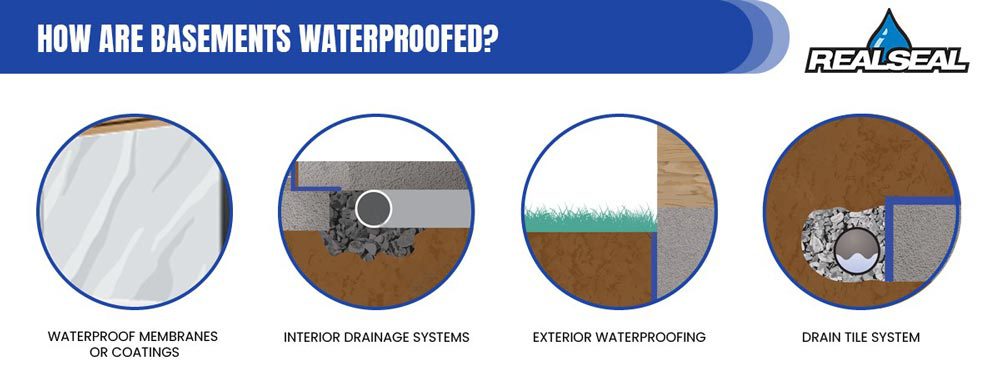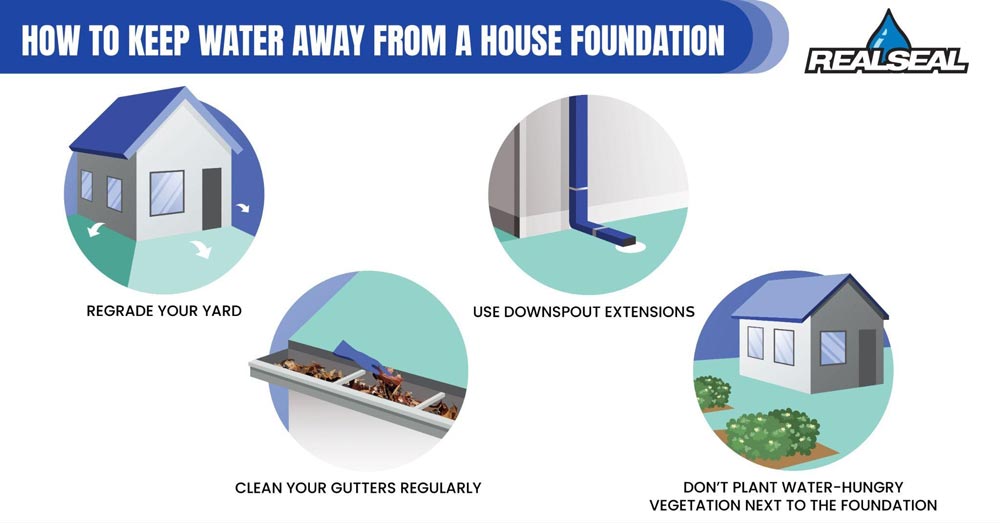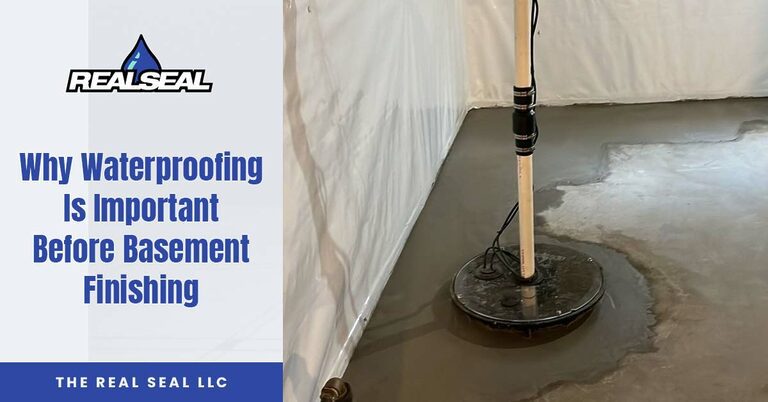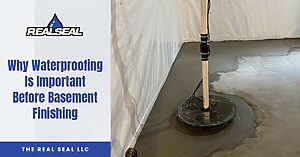Are you looking to finish your basement and maximize the potential of this living space in your home? If so, then completing a waterproofing project before starting any renovations should be at the top of your list. Without addressing underlying water issues, that newly finished basement could be vulnerable to serious damage from moisture–something that no homeowner wants to run into. In this blog post, we’ll cover why waterproofing is essential for any successful basement finishing job, so that you can make sure your investment is as safe and long-lasting as possible.
Why Waterproofing Is Important Before Basement Finishing
Efficient waterproofing is crucial to ensuring the longevity and health of a finished basement. If a basement is not adequately waterproofed before being finished, it will be highly susceptible to moisture ingress, leading to mold growth, wood rot, and structural damage.
Any finishing materials used in a damp basement eventually become at risk of being ruined. For example, moisture can quickly destroy carpeting, leading to mold and mildew growth. Additionally, drywall, wood paneling, and vinyl flooring can all be damaged by water, resulting in costly repairs to the finished basement.
The potential damage inflicted on an improperly waterproofed basement is significant and can result in considerable safety and financial costs. Proper waterproofing can help ensure that your finished basement remains healthy, functional, and enjoyable for years to come.
How Does Water Get into a Basement?
Surface water is one of the most common causes of water intrusion into a basement. Surface water accumulates on the ground surface during precipitation events and does not get absorbed by the soil. Inadequate grading and poor landscaping practices can result in surface water pooling around the house’s foundation, making it an easy entry point for water to penetrate the basement. This could result in structural damage, musty odors, and mold growth.
Another source of basement water intrusion is groundwater. High groundwater levels are expected in regions with a high water table, where the moisture in the soil stays close to the surface. When the soil becomes oversaturated with water, it can seep through the walls, joints, or cracks in the foundation walls, resulting in a wet basement.
Other causes of basement water intrusion include plumbing problems such as burst pipes, leaks, or clogged drains that cause water to accumulate in the basement, leading to water damage and flooding. An inadequate drainage system could also result in water backing up into the basement–especially during heavy rainfall. Sewer backups can also be a source of basement water intrusion, particularly in older homes with outdated sewage systems.
How Are Basements Waterproofed?
There are several waterproofing methods that homeowners may choose to use to ensure the safety and longevity of their basements. One common method is the use of waterproof membranes or coatings. These materials are applied to the walls and floors of the basement to act as a barrier between moisture and the basement interior.
Another popular method is the use of interior drainage systems. These systems involve installing a sub-floor drainage system and sump pump, which collect any water that enters through cracks or gaps in the foundation walls. The collected water is then pumped out and away from the foundation.

Exterior waterproofing involves excavating the foundation walls to the footings, installing a waterproof membrane or coating to the outside surface of the foundation wall, and then adding a drain tile system. This method helps prevent water from entering the foundation walls and reduces the hydrostatic pressure that can lead to foundation wall cracks and water infiltration.
One of the most essential things to remember during waterproofing is the importance of using high-quality materials that will withstand the test of time. Waterproofing professionals with years of experience and expertise can identify the best materials and techniques to ensure that the basement remains dry and safe from water damage.
For more information, see our article 7 Basement Waterproofing Solutions That Work.
How Much Does It Cost to Waterproof a Basement?
The cost of basement waterproofing varies depending on several factors. The size and condition of the basement, the severity of water damage, and the waterproofing method are all significant considerations to bear in mind.
As noted above, basement waterproofing can be achieved through various methods, such as exterior excavation, an interior drainage system, or installation of a waterproofing membrane. The cost of waterproofing a basement also includes repairing any water damage to the walls or floors. This may include removing mold, repairing cracks, etc.
The average cost of waterproofing a basement ranges from $7,000 to $11,000, depending on the method and extent of the repair needed. However, it is essential to note that the benefits of waterproofing your basement outweigh the cost. Waterproofing not only reduces the risk of water damage and mold growth, but also increases the value and safety of your home.
Other Things You Can Do to Help Keep Your Basement Dry
Fortunately, apart from waterproofing, there are things homeowners can do to help prevent water from entering their basement. These include the following:

- Regrade your yard – This involves sloping the yard so that the soil near the foundation slopes away from the house instead of towards it. This will ensure that groundwater doesn’t drain toward the foundation.
- Use downspout extensions – Downspouts that are too short will deposit runoff near the foundation. Extensions are inexpensive, easy to install, and carry water away from the foundation before release.
- Clean your gutters regularly – Clogged gutters can cause water to overflow, run down the side of the house, and soak the ground around the foundation, resulting in water intrusion into the basement.
- Keep water-hungry vegetation away from the foundation – Those flowers and shrubs might look beautiful next to the house, but they also need water, which means you’ll be adding it to the ground around the foundation.
If you’re considering finishing the basement in your Chicagoland home and have questions about waterproofing, contact The Real Seal today to schedule an evaluation and receive a free estimate.







6 Responses
Thanks for this great article. Your company solved a crack in my basement wall and my only regret is that I did not do it sooner and eliminate the anxiety that came with each rainfall. I always had to go down and look for possible water AND I never finished the basement for fear of water damage. Part of that fear was the price tag to fix the problem. Turns out, Real Seal is was an affordable solution, and I would like to thank you for the new homeowners who bought my house knowing they had your warranty to depend on.
My reason for writing this comment is to ask if new homes being built are utilizing these waterproofing methods in the first place? How does a prospective buyer know if any of these methods have been put in place. I dont think my house inspector looked beyond the sump pump.
Kind Regards, Cindy
Hi Cindy,
Thanks for the glowing review! We’re happy to have helped!
Most new homes are required, by code, to have certain things installed including:
Drain Tiles
Sump Pumps & Battery Backups
Exterior Wall Seals
Buried Downspout Extensions
However, they are not required, or even able, to fix foundation cracks. The main reason is that foundation cracks form after the foundation has been poured. Any initial cracks are often just covered with Hydraulic Cement instead of the proper Epoxy Injection. Home Builders are not required to fix these in a real sense, so they cover it up and leave it to be found for later. Home Inspectors are not the all-seeing entities we like to believe they are. Often times, they miss critical things because their knowledge base is heavier in a different trade.
Excellent article! Clear and informative on why waterproofing is crucial before basement finishing. Your insights will definitely help homeowners make informed decisions. Well done
Thank you Paul! Happy to help!
Fantastic post The importance of waterproofing before basement finishing is clearly explained. A must-read for any homeowner
Thank you!